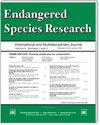南部海獭在北部分布范围的觅食生态为区域种群动态提供信息
IF 2.9
2区 环境科学与生态学
Q2 BIODIVERSITY CONSERVATION
引用次数: 0
摘要
ABSTRACT: 海獭(Enhydra lutris)是北太平洋地区重要的关键食肉动物,在海上毛皮贸易期间几乎灭绝。南部海獭(E. l. nereis)的恢复进展缓慢,其大部分历史分布区仍无人居住,导致生态系统功能减弱。许多研究利用觅食指标来评估南方海獭在其目前分布区的种群状况,但对其北部分布区的情况却知之甚少,因为北部分布区的扩张停滞限制了其恢复。因此,我们从 2019 年到 2021 年在加利福尼亚州 Año Nuevo 州立公园收集了海獭的普查和觅食数据,以确定北部分布区边缘的海獭丰度、食物组成、食物多样性和平均能量摄入率。然后,我们将 Año Nuevo 的数值与之前从加利福尼亚其他地点收集的数据(包括高密度、分布中心地点和低密度、分布边缘地点)进行比较,评估区域种群状况。我们发现,Año Nuevo 的海獭密度高于北部分布区外围的周边地区,平均(±95% CI)能量摄入量(9.51 ± 0.91 kcal min-1)更接近于在高密度地点观察到的数值。此外,膳食多样性(采用香农-维纳指数,H)介于先前研究的高密度和低密度种群之间(H = 1.81),螃蟹在膳食中所占比例最大(约 56%)。总之,这项研究强调了占领时间和分布区停滞可能造成的影响,确定了阿诺努埃沃猎物资源基础的独特方面,并为持续缺乏北部分布区扩张提供了见解。本文章由计算机程序翻译,如有差异,请以英文原文为准。
Foraging ecology of southern sea otters at the northern range extent informs regional population dynamics
ABSTRACT: Sea otters Enhydra lutris are vital keystone predators throughout the North Pacific that were nearly extirpated during the maritime fur trade. Recovery of southern sea otters E. l. nereis has proceeded slowly, with much of their historical range remaining unoccupied, resulting in reduced ecosystem functioning. Numerous studies have used foraging metrics to assess the population status of southern sea otters throughout their current range, but little is known about the northern range extent, where a stall in expansion has limited recovery. Thus, we collected census and foraging data of sea otters at Año Nuevo State Park, California, from 2019 to 2021 to determine sea otter abundance, diet composition, diet diversity, and average energy intake rate at the northern range edge. We then assessed regional population status by comparing values from Año Nuevo with previously collected data from other locations in California, including high-density, range center sites and low-density, range periphery sites. We found that sea otter density at Año Nuevo was greater than surrounding areas at the northern range periphery, and the average (±95% CI) energy intake (9.51 ± 0.91 kcal min-1) more closely resembled values observed at high-density sites. Further, dietary diversity (using the Shannon-Wiener index, H) was intermediate between previously studied high- and low-density populations (H = 1.81), with crabs making up the largest proportion of the diet (~56%). Overall, this study highlights possible effects of occupation time and range stagnation, identifies unique aspects of the prey resource base at Año Nuevo, and provides insight into the ongoing lack of northern range expansion.
求助全文
通过发布文献求助,成功后即可免费获取论文全文。
去求助
来源期刊

Endangered Species Research
BIODIVERSITY CONSERVATION-
CiteScore
5.50
自引率
6.50%
发文量
38
审稿时长
31 weeks
期刊介绍:
ESR is international and interdisciplinary. It covers all endangered forms of life on Earth, the threats faced by species and their habitats and the necessary steps that must be undertaken to ensure their conservation. ESR publishes high quality contributions reporting research on all species (and habitats) of conservation concern, whether they be classified as Near Threatened or Threatened (Endangered or Vulnerable) by the International Union for the Conservation of Nature and Natural Resources (IUCN) or highlighted as part of national or regional conservation strategies. Submissions on all aspects of conservation science are welcome.
 求助内容:
求助内容: 应助结果提醒方式:
应助结果提醒方式:


